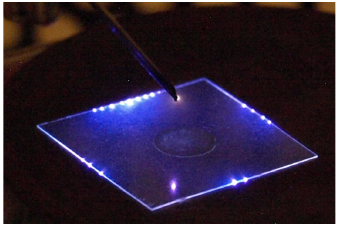
Recovery and resilience plan.


In bio-decontamination by cold plasmas, it is very important to assess the role of various mechanisms involved. Despite there is no general consensus among the authors, the significant mechanisms depend strongly on the plasma composition (gas), temperature, treated microorganisms and the environment, in which they are (air, water, surfaces, etc.). In atmospheric pressure plasmas, the major role is typically attributed to radicals and reactive oxygen species. We identify the dominant mechanisms by comparing the electrical characteristics of the investigated discharges, their emission spectra, bio-decontamination effects in various discharge and flow regimes, TBARS detection of oxidative stress of microbial cells, and by various methods of separation of biocidal plasma agents. Comparing direct with indirect plasma effects enables separation of various biocidal plasma agents: electric field, charged particles, neutral reactive species, UV radiation (Machala Z., et al., 2010).
Figure 1 schematically depicts the arrangements for comparison of direct and indirect plasma effects on contaminated agar surfaces to separate various biocidal plasma agents. We compared direct streamer corona and TS plasma treatment with two types of indirect exposure obtained by 1) filtering the charged particles and electric field from neutral radicals and excited species; and 2) applying only UV radiation from the plasma.
Figure 2 shows the photographs of the Petri dishes with contaminated agar after direct vs. both indirect treatments together with the untreated control sample, and a sample treated with 50 μL droplet of liquid ethanol (96%) for comparison. The effects of plasma (and ethanol) on contaminated agar are clearly visible as dark voids, whereas control sample is homogeneously covered by cultivated bacteria (bright). Dark voids with bright spots represent incomplete decontamination (e.g. with ethanol), the spots are CFUs grown from single bacteria. With respect to the total number of bacteria spread on one Petri dish (106), a few tens of survived bacteria that cause these bright CFUs in the voids are quite negligible.
Both direct plasma and indirect exposures to neutral reactive species (and partial UV) caused apparent bio-decontamination (voids). Streamer corona (SC) resulted in a larger treated area on the Petri dish, likely due to the electric wind that drives the active species from the point electrode towards and along the agar surface in one preferential direction. TS treatment is more localized in the center of the dish but more intense.
It was demonstrated that the direct exposure to the plasma and indirect exposure to separated active neutral species generated in the plasma had almost the same effect on bacteria. On the other hand, separated plasma radiation, including UV, had no significant effect. These investigations, together with the emission spectra of the discharges, indicated the major role of radicals and reactive oxygen species, such as O, OH, or O3 (Machala Z., et al., 2010).
Their role in the plasma treatment was confirmed by the absorption spectroscopic detection of the products of microbial cell membrane oxidation stress in TBARS (thiobarbituric acid reactive substances) method. Figure 5 shows the TBARS concentration gain Δc(TBARS) correlated with the bio-decontamination efficiency of SC and TS applied to the electro-sprayed water. The same bacterial samples were irradiated by biocidal UV C radiation (Hg lamp, 254 nm, 1 min) for comparison. UV C radiation induced almost no Δc(TBARS) despite its bactericidal efficiency was very high. Obviously, UV dominant biocidal mechanism is not peroxidation of cell membranes. On the contrary, SC and TS plasma treatments significantly enhanced the TBARS concentration. This indicates that oxidations of cell membranes by ROS are important in microbial inactivation. More ROS is linked with the higher efficiency.
Together with the spectroscopic discharge investigations we determined some important mechanisms in the bio-decontamination process, especially the major role of radicals and active species, generated especially in TS with strong short pulses. Most importantly, OH, NO and atomic H, O, and N radicals were detected. This result correlates with the dominant radical mechanisms referred by other authors (Machala Z., et al., 2010).